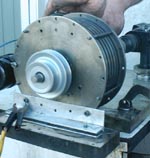
Quasiturbine Aviation
Multi-fuel air-cooled ultra-light ULM airplane engine
In a propeller airplane, weight
reduction allows a larger payload or longer autonomy,
space saving allows to reduce the aerodynamic drag,
absence of vibration increases instruments reliability, photos quality and
flight comfort,
the noise reduction increases the discretion level,
the high torque allows the use of multi-blades propeller
and the better intake characteristic of the Quasiturbine allows higher flight
altitude.
In an helicopter, a large diameter
Quasiturbine could generate enough torque
to directly drive of the rotor blades without any gearbox,
while making much less noise.
Note on the low sensitivity of the Quasiturbine to thermal
shock:
The high sensitivity of air-cooled piston engine to
thermal shock (which
reduces its reliability in aviation)
results from the fact that the piston interior is cooled by a flow of cooling oil
that stays hot,
while the cylinder is cooled by an air flow.
The air-cooled Quasiturbine is much less sensitive to thermal shock,
since both the stator and the rotor are cooled by an air flow and react
simultaneously
the same way.
Engineering of a small air-cooled Ultra-light ULM
Quasiturbine engine
in the range of 70 to 100 HP
is almost completed.

Construction of an experimental prototype is a priority for 2002.
Hybrid Quasiturbine-Fan (or Quasiturbine-Jet)
No temperature limit in the jet nozzle!
Considering the high power density, the
low cross section area and the exceptional intake characteristics of the
Quasiturbine,
it is reasonable to expect to conceive an airplane engine:
1) Quasiturbine-Fan
in which the Fan would
be driven by a Quasiturbine,
rather that by a conventional power turbine.
2) Quasiturbine-Fan Hybrid
in which only the compressor would be driven by a Quasiturbine,
leaving all the reactor energy available to drive a still more powerful Fan.
The Quasiturbine air intake could come from the compressor.
3) Quasiturbine-Jet reactor (no hot turbine)
Still more revolutionary would be a Jet Reactor without power
turbine in the hot gas flow,
where the compressor would be driven by a Quasiturbine, leaving to the Jet all
its propulsive energy.
The Quasiturbine air intake could come from the compressor.
In this last case, the suppression of the
conventional power turbine
would permit to operate the engine at much higher temperature without risking to
melt the non-existent power turbine,
and would permit to substantially increase the efficiency.
This airplane engine would operate in the same mode as the rocket engines!
For still a higher power density,
the Quasiturbine could be fueled in pneumatic
mode in hydrogen peroxide.
Those concepts would also permit to construct much less
complicated airplane engines
and at a much lower cost than conventional turbines.
| Return to main menu |
Quasiturbine Aviation Inc., Promotional
Agent for the Quasiturbine Continuous Combustion Rotary Engine or Compressor
Casier 2804, 3535 Ave Papineau, Montréal Québec H2K 4J9 CANADA (514) 527-8484 Fax (514)
527-9530
http://quasiturbine.promci.qc.ca
quasiturbine@promci.qc.ca